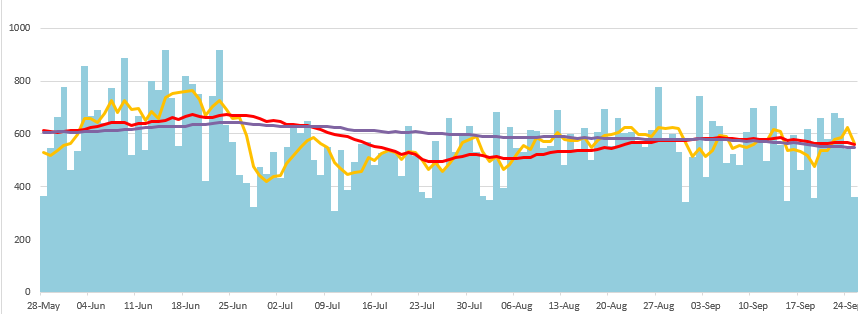My main tools for measuring my daily activities are a Fitbit and a Heart Rate Monitor. The Fitbit gives me a good idea of how much I've been active, and the Heart Rate Monitor gives me an idea of the intensity of my activities.
My main aim is to avoid PEM (Post Exertional Malaise) because that can lead to long-term losses in my ability. In this post I'll explain how I use my Fitbit, and in another I'll describe my tactics for using a heart rate monitor.
My Fitbit
I've been using a Fitbit One since November 2012. It measures my daily steps, my active time, and also gives me an idea of my daily calorie burn. Here's a screen shot from my profile page today. (There is also a feature for recording sleep but I've stopped using it.)
One of my aims with this, is to always walk slowly enough that the orange "fairly active" line (in the time active graph) stays close to zero. At first this was incredibly difficult, but over time I've become better at taking things slowly. Obviously the red "very active" line never wavers upwards!
I have also created an Excel spreadsheet into which I enter my daily steps. & I've set it up to produce some pretty graphs. :-)
Anyway, I've decided to be brave, and share some of this personal data, in the hope that it will help others to understand. So this is a scatter graph of all my daily steps since I began recording almost 2 years ago.
I became ill with ME 8 months prior to the start of this graph, and the most recent dip down was due to a virus at the beginning of the summer. Other dips, I suspect, were related to my attempts to do things two or three days in a row.
My Excel sheet also does some rolling averages: I tend to watch my 5 day rolling average (yellow line in chart below) quite carefully. If I see it creeping up, then I try to take a quieter day or two. Often it is not the single day up that is a problem, but rather when I do slightly more for several days in a row.
The most dangerous time is when I "feel better" for a few days. It is also when it is most difficult to pull back! The drop in this chart however, was that summer virus I mentioned earlier!
Blue columns - daily steps
Yellow line - 5 day rolling average
Yellow line - 5 day rolling average
Red line - 30 day rolling average
Purple line - 100 day rolling average
Purple line - 100 day rolling average
The red and purple lines, are 30 and 100 day rolling averages, and they give me a clear idea of where my activity level currently lies. I aim to be consistent from day to day, but it's not easy. A low step count like this means using a mobility scooter beyond the house, and also restricting what I do inside.
I also try to make a note of other activities that add to my daily exertion levels, such as going out to a coffee shop, or to agility training with my pup. I write these down beside the raw data (and rolling averages) for each day, with the idea that I can check back for patterns.
I'm not very good at recording subjective data about how I feel. I did try for a while, but no grading system seemed to work for me. To be honest, I think that steps are a fairly clear indication of how well I am anyway: I don't do fewer steps without good reason.
Looking forwards: Although that scatter graph above looks depressing, I think it is clear that I have at least managed to halt the early relapses that were probably caused by trying to do too much. (However, I regard that summer virus, as bad luck not bad management.)
I've no doubt my Fitbit helps me to moderate my daily activities in such a way as to minimise the chances of further relapses. In this way I believe I am giving myself the best chance of recovery, whilst still managing to do some stuff I enjoy. However the Fitbit doesn't really help me manage activities "in the moment". For that I use a heart rat monitor.
Edit to include post on HR monitoring: Starting Heart Rate Monitoring for ME
***************
PS If anyone would like a copy of the Excel spreadsheet that I have created, please let me know and I can email it out for your personal use. I can be contacted at: keelatoo@ live. co. uk (omitting the spaces ;) )
Other related posts:
"Play-Up & Lay-Up" not "Boom & Bust"
"Play-Up & Lay-Up" not "Boom & Bust"




